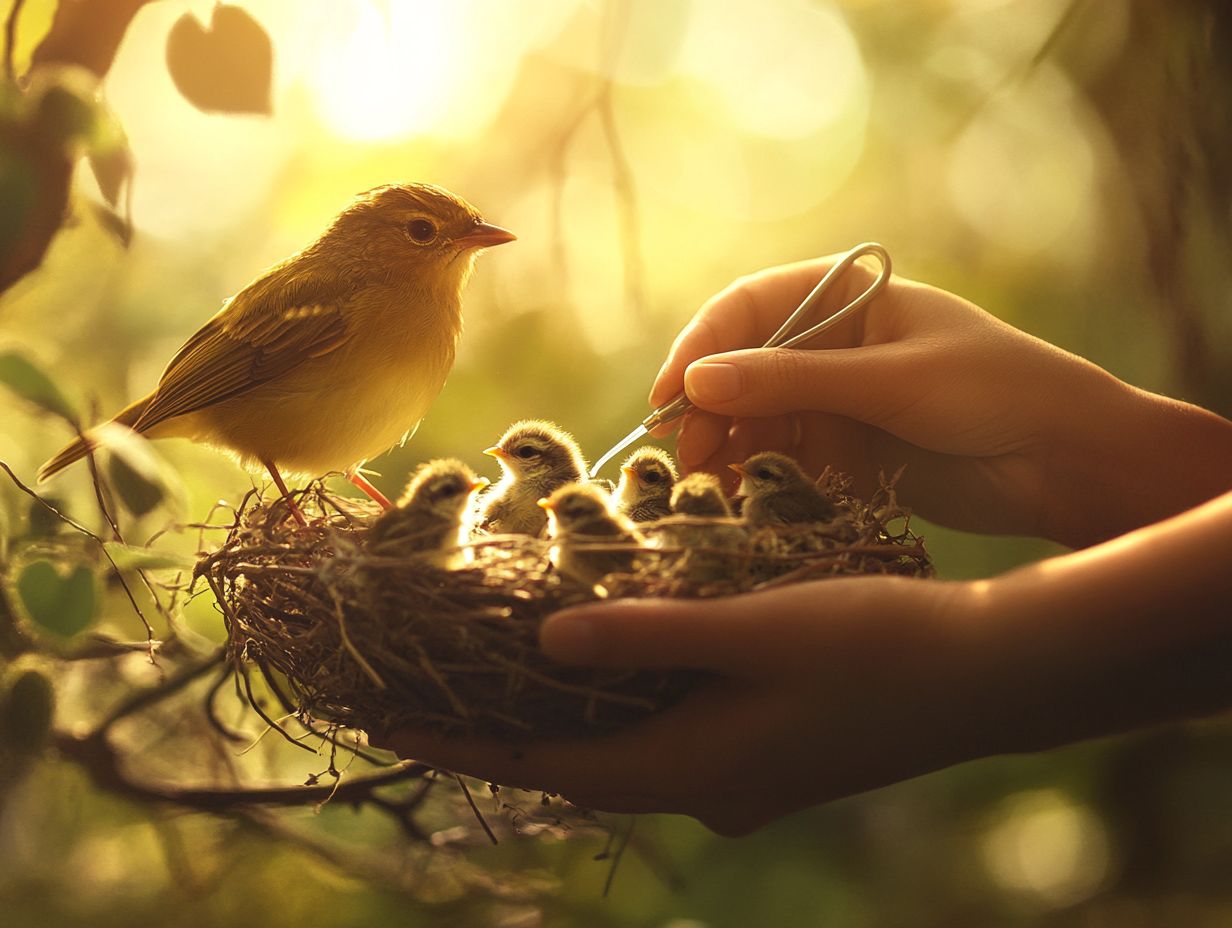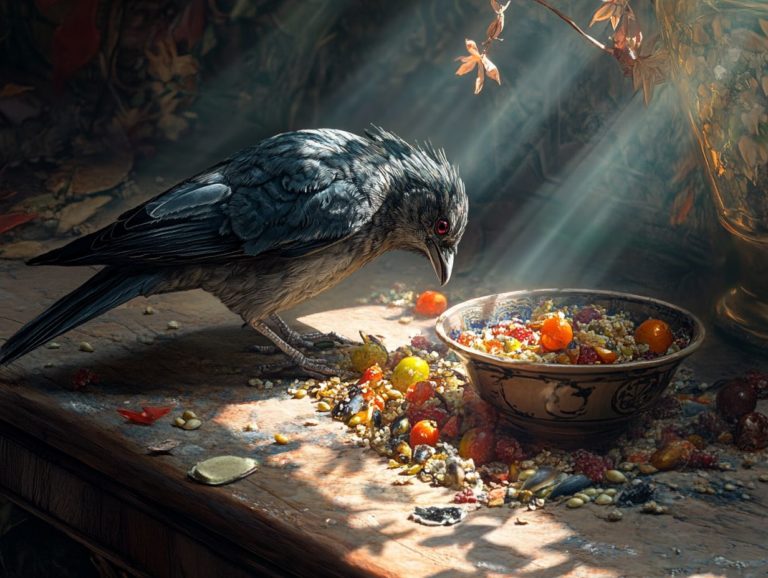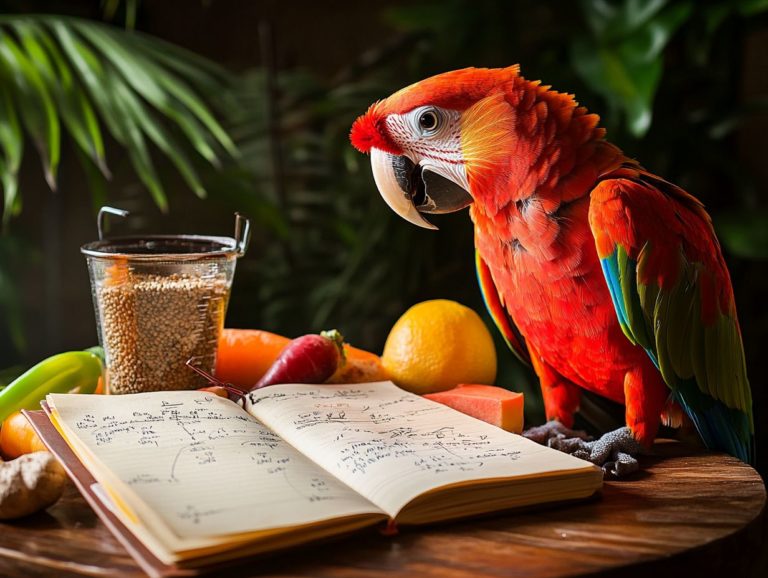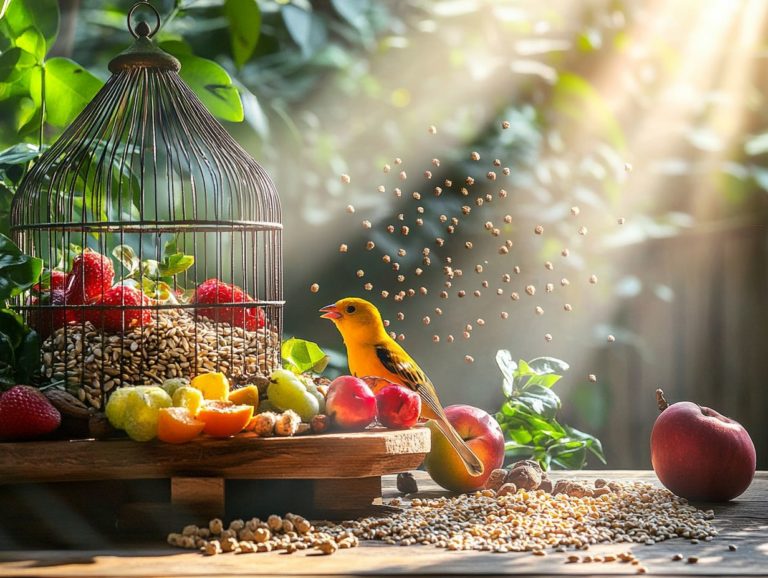5 Best Tips for Feeding Baby Birds
Discovering a baby bird in distress can elicit a mix of warmth and concern. When you come across a tiny feathered friend in need, it’s vital to know how to help with baby bird care.
Here are five essential tips for feeding orphaned baby birds. This guide will help you assess whether the bird truly needs help, create a secure environment, and provide it with the right diet.
Empower yourself with knowledge from experts, like Natalie Punt, DVM, to ensure your newfound companion not only survives but thrives!
Contents
- Key Takeaways:
- 1. Make Sure the Bird Is Actually an Orphan
- 2. Create a Warm and Safe Environment for the Bird
- 3. Properly Hydrate the Bird
- 4. Feed the Bird a Suitable Diet
- 5. Monitor the Bird’s Progress and Seek Professional Help If Needed
- What to Do If You Find a Baby Bird?
- Frequently Asked Questions
- What are the 5 best tips for feeding baby birds?
- How often should I feed baby birds? (Including Feeding Schedule)
- Can cow’s milk harm baby birds? (Consulting a Veterinarian)
- What if the baby bird won’t eat? (Emergency Care)
- Is it safe to feed baby birds cow’s milk? (Feeding Tips)
- How do I know if the baby bird is full? (Caring for Birds)
Key Takeaways:

- Make sure to properly identify if the baby bird is an orphan before taking any actions.
- Provide a warm and safe environment for the baby bird, considering its vulnerability and need for protection.
- Ensure the baby bird is properly hydrated by giving it clean water or specialized rehydration solutions.
1. Make Sure the Bird Is Actually an Orphan
Determining whether a baby bird is genuinely an orphan is vital before taking any action. Many young birds, particularly those that rely on their parents for care, might seem abandoned but are often being looked after by parent birds nearby.
It’s common for adult birds to leave their young unattended for short periods while they search for food, so understanding this behavior is essential for helping wildlife.
You ll notice that orphaned baby birds exhibit specific distress signals, such as relentless chirping or flapping. These signals can help you distinguish between those that are alone and those with attentive parents.
A healthy baby bird, under the watchful eye of its mother or father, is usually quiet and nestled securely, while an abandoned one may appear vulnerable and exposed.
Experts recommend observing the area for signs of parent birds; their return to feed or care for the young is a strong indicator of parental involvement. If you suspect the baby bird is truly orphaned, monitor the situation for a few hours before intervening. Most wildlife experts advise against handling them unless absolutely necessary and encourage reaching out to local bird rehabilitation centers for guidance on taking care of animals.
2. Create a Warm and Safe Environment for the Bird
Creating a warm and safe environment is essential for the survival of a baby bird, especially if you find yourself providing emergency care for an orphaned chick due to circumstances like nest destruction or an animal emergency in the wild.
To achieve this, keep a consistent temperature that mimics the warmth of a mother bird ideally around 95 F for the first week gradually decreasing it as the chick matures. Alongside proper heating, it s crucial to protect the young bird from potential predators, including household pets and other animals.
Using materials like soft towels or shredded paper can help recreate a natural nesting environment, offering the chick both comfort and security. Proper nutrition, including a high-protein diet, is essential for baby bird needs; understanding and meeting all aspects greatly enhance its chances of survival and healthy development.
3. Properly Hydrate the Bird
Proper hydration is paramount in caring for baby birds; dehydration can quickly lead to serious health complications that require immediate intervention from a veterinarian or wildlife rehabilitation expert.
Understanding how to hydrate these fragile beings is crucial for their survival. Ideal liquids for hydration include specially formulated electrolyte solutions, clean lukewarm water, or even a baby bird feeding formula.
Using an eye dropper or a needleless syringe allows you to gently deliver fluids, ensuring the baby bird swallows without the risk of aspiration. It’s vital to observe the bird closely for signs of dehydration, such as lethargy, a dry mouth, or sunken eyes these indicators can provide critical insights into its health and should prompt you to consult with a veterinary expert.
While your home care efforts are significant, consulting with a veterinarian is invaluable for tailored advice and treatment.
When you find a baby bird, it’s important to act quickly and responsibly. Remember to share your experiences and seek help if you’re uncertain about what to do. Your vigilance can make a difference in the life of a vulnerable bird!
4. Feed the Bird a Suitable Diet

Feeding a baby bird the right diet is vital for its growth and survival. These young creatures need a high-protein diet specifically tailored to their nutritional needs, which often includes specialized baby bird food or bird feeding formulas recommended by animal care specialists. For those new to pet birds, following tips for caring for your first cockatiel can be incredibly helpful.
Different bird species have unique dietary requirements. For example, seed-eating species thrive on protein-rich seeds, while insectivorous birds do better with small insects like mealworms. It s essential to find the right food for the specific type of bird you re caring for.
Establishing a feeding schedule is also important. Young chicks need feeding every few hours, while older fledglings can manage with less frequent meals.
Incorporating variety into the feeding routine helps create a balanced meal plan. By adding fruits, vegetables, and commercial diets, you ensure optimal nutrition for baby birds, significantly impacting their healthy development and overall well-being.
5. Monitor the Bird’s Progress and Seek Professional Help If Needed
Monitoring the progress of a baby bird is essential for its health and well-being. If persistent issues arise, consult a veterinarian or a wildlife rehabilitation center for specialized care.
To distinguish between a thriving chick and one in distress, observe key indicators:
- A healthy baby bird shows consistent weight gain.
- It has an alert demeanor.
- Signs of lethargy, poor weight retention, or irregular feeding intervals require immediate attention!
Tracking how often the bird feeds and ensuring it gets the right amount of nourishment are crucial steps. Any noticeable changes in behavior, such as unresponsiveness or excessive vocalization, should prompt swift action.
If you spot any of these warning signs, act quickly! Your little feathered friend needs your help!
What to Do If You Find a Baby Bird?
If you come across a baby bird, your first step is to assess the situation carefully, balancing the animal’s welfare with the instinctual behaviors of nearby nesting birds.
Start by observing the young bird from a distance. Look for signs of distress or injury. Check for feathers if the bird is feathered, it may be in the fledgling stage, practicing its flying skills, and should likely be left alone to develop its natural instincts. If it appears injured or is clearly a nestling without feathers, it may need your assistance.
Identifying the bird species can help you understand its specific needs. If you conclude that rescue is necessary, contact local wildlife care experts or a veterinarian. They can provide expert advice on how to proceed safely.
How to Determine If a Baby Bird Is an Orphan?
To determine whether a baby bird is an orphan, observe its surroundings and behavior closely. Many altricial birds may appear abandoned, yet they are often cared for by parent birds nearby.
As you evaluate the situation, pay close attention to the bird’s physical condition. Look for signs of distress, weakness, or injury. Healthy chicks are usually well-feathered and alert, often vocalizing for food.
Observe the area for adult birds that might be returning or watching from a safe distance; this provides essential context. Wait and see if a parent bird approaches, as many will only be away briefly to forage.
Using techniques like keeping a safe distance and using binoculars lets you gather insights into the young bird’s care status without disturbing its natural habitat.
What Are the Necessary Supplies for Feeding a Baby Bird?

To effectively feed a baby bird, gather some essential supplies. This includes selecting appropriate feeding instruments and high-quality baby bird food specifically formulated to meet their unique nutritional requirements, as recommended by bird care specialists. You can also explore creative ways to feed your bird for a more engaging feeding experience.
Choosing the right types of feeders is crucial. Narrow syringes, specialized spoons, and other feeding instruments ensure that the food is administered safely and effectively. Additionally, implementing 5 tips for training older birds can help in their care. Incorporate specially designed baby bird foods, available in both liquid and powder forms, to provide essential proteins, fats, and vitamins necessary for healthy growth.
Each tool you use plays a vital role in ensuring that these young avians receive proper care, helping to replicate the natural feeding process they would experience with their parents. Using the right supplies enhances the bird s feeding experience and minimizes the risk of aspiration, meaning the risk of food going into the bird’s lungs instead of its stomach, or injury.
What Are the Best Foods for Baby Birds?
- Specialized baby bird food
- Mealworms
- Homemade formulas tailored to various bird species
The best foods for baby birds are typically high-protein options that support their developing bodies. For more detailed insights, consider these 5 key factors for choosing bird food that meet their nutritional needs, promoting healthy growth and feather development.
Incorporate fruits like mashed bananas or finely chopped apples for essential vitamins and hydration.
As a caregiver, prepare suitable meals by blending ingredients into a smooth consistency for younger chicks. Gradually introduce more textured foods as they mature. Observe their reactions to new foods and transition from liquid to solid diets slowly, allowing the birds to adjust comfortably while enjoying a delightful variety on their menu, ensuring proper nutrition.
How Often Should You Feed a Baby Bird? (Including Feeding Tips)
Establishing a consistent feeding schedule is essential for baby birds. Their small bodies require regular feeding intervals to meet nutritional needs and support healthy growth during those critical early development stages. Additionally, having the right gear is crucial; check out these 5 essential supplies for newly adopted birds to ensure they thrive.
Nestlings, those adorable little bundles of feathers, demand frequent feedings often every 15 to 30 minutes throughout the day. As they mature and transition into fledglings, adjust their feeding intervals to about every hour or even more sparingly, depending on the bird species.
Pay attention to their activity levels and hunger cues, which can vary significantly among different bird species. Monitor their development closely to ensure that their feeding intervals align with their growth patterns, creating a thriving and healthy environment for these delightful little avians.
What Are the Signs of a Healthy Baby Bird? (Including Baby Bird Care)
Recognizing the signs of a healthy baby bird is essential for providing proper care. Look for indicators like:
- Active behavior
- Good weight
- Well-formed body
These confirm that the bird is thriving under your watch. If any issues arise, consult a veterinarian.
Beyond these primary signs, take note of the bird’s physical appearance for additional insights. A healthy baby bird usually boasts vibrant feathers, clear eyes, and a clean, unsoiled vent area, indicating robust bird health.
Activity levels are also crucial; an energetic bird that flutters and explores its surroundings is likely in good shape. Monitor its feeding behavior consistent eating habits and proper hydration are strong indicators of well-being, aligning with their baby bird needs.
If any concerning symptoms arise, such as lethargy, feather loss, or changes in appetite, seek expert advice without delay. Early intervention can significantly impact the health and wellbeing of your baby bird, and consulting a bird care specialist can provide guidance.
Frequently Asked Questions

What are the 5 best tips for feeding baby birds?
1. Offer a diet that closely resembles their natural diet: This includes a mix of insects, fruits, and seeds.
2. Ensure proper nutrition with nutritious baby bird food: Look for a formula specifically made for baby birds and follow the recommended feeding guidelines. For a comprehensive approach, check out this complete guide on feeding baby birds.
3. Feed them every 1-2 hours to ensure they thrive: Baby birds have small stomachs and need to eat often, so offer small meals frequently. For more insights, check out these tips for successful bird rehabilitation.
4. Use a syringe or spoon for feeding: These tools allow for precise and gentle feeding, reducing the risk of choking.
5. Gradually introduce solid foods: As the baby bird grows, start introducing small pieces of insects and fruits to encourage natural foraging behaviors. For more on this topic, check out these essential care tips for newly adopted birds.
How often should I feed baby birds? (Including Feeding Schedule)
Feed baby birds every 1-2 hours during the day. As they grow, their crop, a pouch in the throat that stores food, expands, and they will require less frequent feedings, adapting to their feeding schedule.
Can cow’s milk harm baby birds? (Consulting a Veterinarian)
No, baby birds have specific nutritional needs and require nutritious baby bird food. Regular bird seed does not provide the necessary nutrients for their growth and development.
What if the baby bird won’t eat? (Emergency Care)
A refusal to eat may indicate a health issue. Consult a wildlife rehabilitator or rehabilitation expert for proper care and feeding techniques, as they can provide emergency care if necessary.
Is it safe to feed baby birds cow’s milk? (Feeding Tips)
No, cow’s milk is not suitable for baby birds as it can cause digestive issues. Stick to a high-quality formula recommended by a veterinarian or wildlife rehabilitator, and consider using the mPet app for additional assistance.
How do I know if the baby bird is full? (Caring for Birds)
Watch for signs that the baby bird’s crop is full, such as a bulging appearance or a feeling of fullness when gently pressing on it. It’s important not to overfeed baby birds, as it can lead to health issues.






